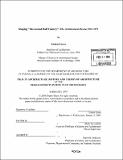| dc.contributor.advisor | Mark Jarzombek. | en_US |
| dc.contributor.author | Erten, Erdem, 1972- | en_US |
| dc.contributor.other | Massachusetts Institute of Technology. Dept. of Architecture. | en_US |
| dc.date.accessioned | 2008-02-28T16:01:31Z | |
| dc.date.available | 2008-02-28T16:01:31Z | |
| dc.date.copyright | 2004 | en_US |
| dc.date.issued | 2004 | en_US |
| dc.identifier.uri | http://dspace.mit.edu/handle/1721.1/17662 | en_US |
| dc.identifier.uri | http://hdl.handle.net/1721.1/17662 | |
| dc.description | Thesis (Ph. D.)--Massachusetts Institute of Technology, Dept. of Architecture, 2004. | en_US |
| dc.description | Includes bibliographical references (p. 297-315). | en_US |
| dc.description.abstract | This study explores the editorial policies of the British periodical, The Architectural Review, in the quarter century between 1947 and 1971. In January 1947, its fiftieth anniversary, The Architectural Review published an editorial manifesto, entitled "The Second Half Century," declaring a program that aimed to influence the postwar reconstruction effort in Britain. In 1971, H. de C. Hastings, the co-owner of the Architectural Review disbanded the editorial board, composed of J. M. Richards (1907-1992), Nikolaus Pevsner (1902-1983), Hugh Casson (1910-1999, who joined in 1951) and himself, which reigned continuously since 1947. In this period, AR ran campaigns in accordance with the program declared in "The Second Half Century." Articulating a trajectory for the future of the periodical, the editors not only aimed to shape post-war modem architecture in Britain, but also around the world. They reinterpreted British romanticism in order to conceptualize a model of environmental intervention, known under the rubric of "Townscape." The scope of this program, however, was far larger than the mere urban design methodology that "Townscape" stands for today. It was linked to a project of cultural continuity and renewal. The reinterpretation of British romanticism provided a field of negotiation with the tendencies of modernism-e.g. the ascendance of bureaucratic and technocratic expertise, rationalization of industrial production and increasing specialization-that the editors held responsible for creating an unacceptable uniformity and a sense of alienation. By analyzing the dialogue between the written works of the editors and the specific selection of material included in the periodical, this study aims to clarify the nature of AR's postwar effort by questioning | en_US |
| dc.description.abstract | (cont.) the conflicting models of progress it harbored. It aims to reveal its complex position with respect to cultural continuity, modernity and avant-gardism. Pointing toward the cultural ideals that underlined this position, it covers an interdisciplinary territory that existed in the background where the editors drew the argumentative core of their polemics; a territory that covers the history of political science, cultural anthropology and art history in order to provide a depth of understanding and to reveal the larger constituency and hybridity of architectural discourse. | en_US |
| dc.description.statementofresponsibility | by Erdem Erten. | en_US |
| dc.format.extent | 323 p. | en_US |
| dc.language.iso | eng | en_US |
| dc.publisher | Massachusetts Institute of Technology | en_US |
| dc.rights | M.I.T. theses are protected by copyright. They may be viewed from this source for any purpose, but reproduction or distribution in any format is prohibited without written permission. See provided URL for inquiries about permission. | en_US |
| dc.rights.uri | http://dspace.mit.edu/handle/1721.1/17662 | en_US |
| dc.rights.uri | http://dspace.mit.edu/handle/1721.1/7582 | |
| dc.subject | Architecture. | en_US |
| dc.title | Shaping "The Second Half Century" : the Architectural Review, 1947-1971 | en_US |
| dc.type | Thesis | en_US |
| dc.description.degree | Ph.D. | en_US |
| dc.contributor.department | Massachusetts Institute of Technology. Department of Architecture | |
| dc.identifier.oclc | 55636535 | en_US |
